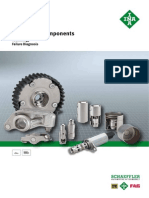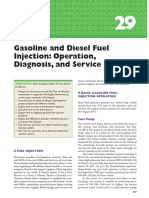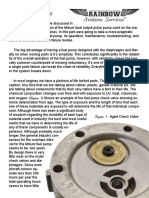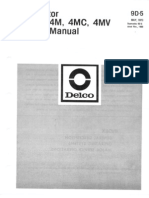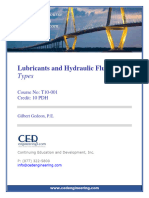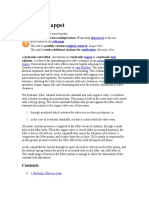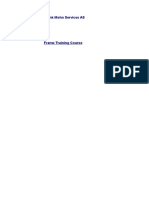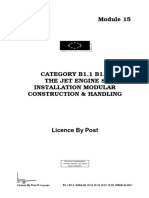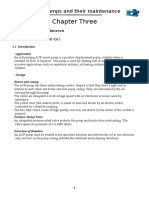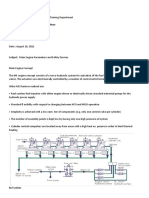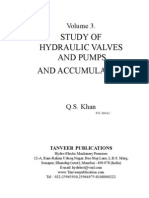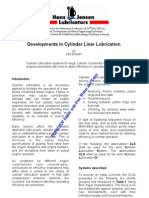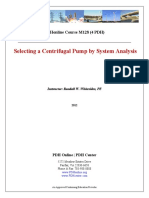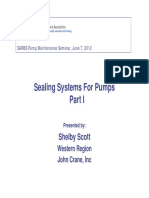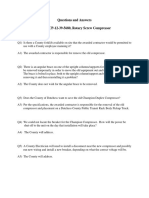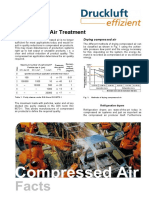Problem in Steam Turbine Lubrication
Problem in Steam Turbine Lubrication
Uploaded by
mishraenggCopyright:
Available Formats
Problem in Steam Turbine Lubrication
Problem in Steam Turbine Lubrication
Uploaded by
mishraenggOriginal Description:
Copyright
Available Formats
Share this document
Did you find this document useful?
Is this content inappropriate?
Copyright:
Available Formats
Problem in Steam Turbine Lubrication
Problem in Steam Turbine Lubrication
Uploaded by
mishraenggCopyright:
Available Formats
PARTICULAR PROBLEMS OF STEAM TURBINE LUBRICATION
by
Walter E. Enz
Manager, Turbine Controls
and
Alfred Hausermann
Chief Turbine Design Engineer
BBC Brown, Boveri Company, Lmited
Baden, Switzerland
Wlter E. Enz, a native of Switzer
land, was graduated as a mechanical en
gineer from the Institute of Technology
at Winterthur. After three years of de
sign practice in Fance and England, he
joined th Escher Wyss - Oerlikon Com
pany as a steam turbine engineer.
In 1961 he was employed by the Brown
Bover Company f their large Steam
Turbine Department. Two years later, he
became a chief design engineer of gears
for turbomachinery and marine application. From 1969 to
1974, he was responsible for component standardization of the
Brown Bover - Sulzer Turbomachinery Ltd. He rturned to
Brown Bover to join the Industral Steam Turbine Control
Departmnt where he was prombted to his present position as a
manager.
A native of Switzerland, Alfred
Hiusermann graduated as a mechanical
engineer fom the Lucerne State Institute
o Technology. In 1966 he was employed
by the Brown Boveri Company as a
steam turbine engineer. He worked there
fo four years in the department for de
sign and development of large steam tur
bines. In 1970 he joined the Turbine
Testing Departmnt. As a senior eng
neer, he was engaged in commissioning
of large turbines and troubleshooting in steam power plants.
In 1975 he was promoted to a chief engineer and changed to
the Industral Steam Turbine Deparment. He is responsible fo
dsign and mechanical calculations of industral and medium
sized steam turbnes.
`t^'
The reliability of a steam turboset is dependent, among
other things, on correct fnctioning of its hydraulic lubrication
and control system.
An essential requirement is a reliable oil supply over the
whole operating range. Te main oil pump carries to a large
degree this responsibility. The design and operational aspects
of it will be dealt with in this papr.
Air dispersed in oil is known to endanger, in extreme
cases, the safe and reliable operation of the turbogroup. Be
sides operating interferences of various system components an
interruption of oil supply to the bearings may result in serious
consequences. Without going into details of oil qualities, oper-
I2
ational consequences as well as corrective measures, of air
present in oil will be discussed.
The increasing specific demands imposed upon steam tr
bines may bring about new oil system difculties. The subject
matter presented here treats extreme cases of thermal loading
of the lube oil as in the case when coming into contact with hot
turbine parts. The resulting coke deposits in bearings may
cause filure. \ith the assistance of experimental comparison
tests lube oils on this basis are selected that will have the
inherent capabilities to withstand such extreme operating con
ditions.
`t\1!'\^
In the fllowing, several problems pertaining to the relia
bility of turbine oil systems will be discussed.
Maintaining reliable oil supply over the whole operat
ing range.
Reducing the influence of the inevitable air trapped in
oil to a safe operating minimum.
Trouble free lubrication also in cases of high lube oil
temperatures.
When working on such a problem subject it soon becomes
evident that design and operational aspects in particular have
priority. An attempt is made to present difculties and their
successful solutions based on actual operating experience.
HYDRAULIC CONTROL AND
LUBE OIL SYSTEM
Systems built up as for example shown on Figure 1 have
three main contributions to make towards operational safety:
Control and lubrcation during normal trouble-free op
eration.
Protection of the turboset by reducing load or outright
tripping when inadmissable malfunctions occur.
Damage-free runout of the turboset after an emergency
trip. This entails continuation of an adequate oil supply
to the bearings.
It is quite clear that all system components contribute to
the fulfllment of the above requirements: A closed hydraulic
circuit has proved highly effective for the control (CS) and
protection (PS) systems.
The constant pressure valve (CV) and the pressure reduc
ing valve (RV) must be absolutely surge- and vibration-free in
order to prevent fuctuations within the system. Experience
has shown that simple spring-closed valves are not quite up to
I2b V1OL1111^!5 O1 J11 51V1^J1 J!11ON^L11^111 51NVO51!N
1Y
Figure 1. Schemtic of Turbine Control and Lubrcating Sys-
ter.
T Turbine L Cooler
G Gear Box Lb Control System
DM Drven Motor PS Protection System
MP Main Oil Pump 1 Turbine Control Valve
AP Auxiliar Oil Pump LY Constant Pressure Valve
F Filter RV Pressure Reducing Valve
the task in question. Quite often suitable dampening may help
to solve the problem.
The main oil pump (MP) plays an important part in reach
ing the three main objectives mentioned at the beginning of
this section. Oil fow must be guaranteed during all phases of
operation. In a later section the relevant criteria and possible
solutions will be discussed in detail.
As far as the flter (F) is concerned, the problems mostly
center on flter quality, flter cleaning and cleaning intervals.
The cooler's (C) main problem is the choice of heat exchanger
tube material. In both cases a reliable change-over capability
must be ensured when, for reasons of availability, two flters or
coolers are installed in parallel, one being in service, the other
on stand-by. Thereby an efective deaeration is of greatest im
portance; this problem will be discussed in the later section
"air in oil. "
t1111 \1 `!111J
Main Oil Pump Drive Variants
The reliability of a pump depends to a large extent on the
drive method chosen.
Bearing failures of rotating machinery can occur when the
oil supply is disrupted in some way. This can happen when an
electric pump drive motor fils due to a power failure or mal
fnction of the protection system. A mechanical pump drive off
the main shaft has the inherent advantage of uninterrupted uil
fow for as long as the shaft is turning.
Mechanical drive of the pump is taken off the main shaft
over a gear train with the appropriate drive ratios. Various
arrangements are possible (see Figure 2).
The simplest case is (a). A single pump for lube and control
oil pressurizes the system at 5 - 10 bar.
Case (b) comes into effect when pressure in the control oil
system has to be at a different (higher) level. This pump is
divided up into a high-pressure section delivering control oil at
a pressure of 10- 25 bar, and a low-pressure section for lube oil
|1
COMBINLO LuBL ANO
CON!HOL OIL PuMP
ttJ
LP LuBL OII PuMP
HP CON!HOL OIL PuMP
|1
3HAI! OHIvLN
LP LuBL OIL PuMP
MO!OH OHIvLN
HP CON!HOL ILuIO PuMP
Figure 2. Schemtic of Main Pump Drves for Lube and Con
trol Oil Supply.
at 3-5 bar. A HP: LP delivery ratio of approximately 1:4 is
considered most efctive. If the turbo set in queston has a gear
train with above normal oil requirements, an extra pump can be
installed to cater especialy for these.
Te main priority lies in a reliable supply of low-pressure
lube oil. The low-pressure pump should therefore be driven
mechanically of f the turbine shaft. Case (c) on Figure 2 shows
another possible alternative with the high-pressure control oil
pump driven by a separate electric motor. This variant has the
advantage that the control oil pump can be shut down im
mediately in the event of a malfunction in the system.
A Failure-Free (Robust) Pump
Volumetric pumps are prefrable as opposed to centrifgal
pumps when used as main oil pumps. Oil fow is approximately
proportional to shaft speed and supply pressure can be feely
chosen within certain design limits. In contrast, the centrif1gal
pump has a speed-dependent pressure/ow characteristic
which is variable and not always easy to ft to the requirements
of a given system. Mechanically driven volumetric pumps can
be designed as gear (helicoidal) or screw-type pumps.
Taking a gear pump as shown on Figure 3 as an example,
the following are relevant for safety and reliability of operation:
The teeth of the driving gears should be hardened and ground
for long service life and to operate at the minimum noise level.
The same goes for the pump gear pinions themselves.
The pump must be equipped with robust and durable
bearings. Plain bearings with babbit or bronze bearing surfaces
have proved most suitable. Experience has shovvn ball and
roller bearings to have irregular service lives and to be unsuit
able for use in main turbomachinery components. On the drive
side the pump should be equipped with an especially tough
bearing to take on the heavy radial and axial loads at this tmd.
Figure 4 shows a twin pump with separate high and low
pressure sections built according to the above design princi
pals.
Pump's Suction Power and Noise Level
Apart from robust design and long service life the main oil
pump must ha'e a powerful suction capability and must oper
ate within acceptable noise levels. Both requirements are lim
ited by cavitation. Operational experience over many years and
numerous tests have shown which methods can be employed to
move the cavitation limit towards better suction and lower
noise levels:
Air content in the oil must be as low as possible, an
acceptable level being less than 4% of volume at atmo
spheric pressure (I bar).
V^1J1L!1^1 V1O111N5 O1 5J1^N J!111^1 1!111L^J1O^ I2T
Figure 3. Gear Type Oil Pump Drven of the Turbine Main
Shaft.
Figure 4. Gear Type Pump With Separated Sections for Lube
and Control Oil
Peripheral speed measured at the outside diameter of
the pump gear pinions must not exceed 10-11 m/s.
Noise levels are strongly influenced by the clearance
between gear teeth and the inside of the pump casing.
Small clearances lead to higher pumping efficiency but
also raise noise levels considerably.
The oil compression chamber formed by two gear teeth
returning to the suction side of the pump must be
pressure-relieved by slots in the sides of the casing [1].
The suction chamber of the pump must be of optimum
design. Figure 5 shows the stages in which the optimum
shape II envolved from the originally simple shape I
over an intermediate variant with very large suction
chamber. The inlet channel is shaped so as to allow for
gradual and complete flling of the gaps between the
gear teeth.
Systematic evaluation of a number of test results have led
to an extension of the caviation limit. Suction head (H) of the
pumps incorporating the above-mentioned design im
provements has been raised from level I to level II as shown on
Figure 6. Sound pressure levels (S), measured 1 m away from
II
Figure 5. Improvement on Gear Pump Casing Shape.
s
U P
H
mLlL
t
JJ
J
`
4
Z
Il
'I
J JJ JZ
um/s
LLPH 1lV VLLO
VHLVlLU OLlLN }
ll lWVHLVLO OLlLN
LL |lL.
lll PLLLWPLL WLHAlNL PHLP
|LH H PNO U
Figure 6. Attainable Suction Head H and Sound Pressure Level
S for Gear Pumps.
Iz V1OL1111^!5 O1 J11 51V1^J1 J!11ON^L11^111 51NVO51!N
the pump casing, are not overtly high when compared with the
overall turbine noise levels. Area III denotes the H/U range for
safe operation.
A pump with a good suction capability gets oil fowing
very quickly. Supply only ceases when shaft speed sinks below
5% of maximum revs. The reliability bonus of a pump driven
directly off the main turbine shaft is a result of this characteris
tic.
Incidents in a number of plants have shown that industrial
turbines can run out without incurring bearing damage. This
indicates that in the event of a turbine trip, when the auxiliary
pumps are out of action due to malfnction or power failure, oil
supply from the main oil pump suffices to guarantee a damage
free runout.
A mechanically driven main oil pump must also be de
signed to run backwards without incurring damage. Running
backwards can occur in turbosets driving compressors or
pumps when the medium to be transported fows in the re
verse direction due to leaking or jammed valves.
AIR IN THE LUBRICATING OIL
AND IN ITS SYSTEM
Air dissolved in oil and air-oil solutions are repeatedly
known to have caused problems when used for lubricating pur
poses and hydraulic control fnctions of turbomachinery [2].
Problem areas are:
Pressure surge in oil system
Interruptions in oil supply
Excessive formation of foam etc.
These negative effects of air present in oil can be elimi
nated to a great extent provided that the specifc application
requirements of te oil are obserVed and consideration be
gven to suitable design methods.
Following, a number of viewpoints on the problem cycle
"air in oil" are given.
Type of Air in Oil
Figure provides information on various types of air pres
ent in oil.
1. Air Dissolved in Oil
Mineral oils, as well as all liquid mediums have the
inherent capability to dissolve specifc quantities of gas in
molecular form without notceable changes in their specifc
properties such as viscosity and compressibility. The mass
of air taken up by the mineral oil in a dissolved state is solely
a function of pressure and amounts, under atmospheric
conditions, to approximately nine percent per volume. In
theory, the potental air absorption ability is proportional to
the pressure; that is to say, when pressure drops occur (e.g.
at suction pump inlet) a certain quantity of the dissolved m
volume is liberated. At a pressure increase, part of the air
mass present in oil is again dissolved, however, a specific
mass of air always continues to remain dispersed as bubbles
in the oil. In general, air dissolved in oil does not infuence
its technical application for turbomachinery and can there
fore in most cases be neglected.
2. Air Bubbles in Oil
At the oil consumption points (e.g. bearings, control
devices, gear boxes) oil is scattered and partly mixed with
air. Te discharged lube oil of the turbogroup is therefore
diffsed with air. The air is present in small bubbles of
approximately 1/100 to 1 mm and amounts to 2-10 percent
by volume, giving rise to a considerable effect on viscosity
and compressibility of the oil [3]. Oil condition (effect of
additives, contamination etc.) is, besides the mechanical
causes already mentioned, also responsible for high air con
tent.
3. Foam Formation on Oil Surface
A strong foam formation is, in addition to high air con
tent, also based on the inherent tendency of the oil to pro
duce foam [ 4]. Experience has shown that the machines are
not endangered provided foam formation is kept within
limits (foaing over of container).
4. Air Plug in the System
In an oil system, large empty spaces such as is the case
with standby oil coolers, standby pumps and standby filters,
however not flled with oil, are fnctionally integrated in
the cycle. If such devices are taken into operation without
foregoing deaeration, the total air volume is transferred to
the consumer. Due to the size of these air volumes, the
formation of correspondingly large air plugs result. As a
consequence, interrupted oil supply to the machines
endangers its operation. The formation of air plugs will be
discussed later in detail.
Efect of Air in Oil
With the following two examples, operational conse
quences of air in oil will be presented.
1. Change-Over of Coolers and Filters
Oilcoolers and oilflters are, in order to have 100%
standby, often introduced as a duplicate parallel oil circuit
into the lube oil system. Te change-over fom cooler one
(filter) to cooler two (flter) is accomplished by means of
coupled three-way valves located at inlet and outlet of cool-
ers.
Cooler and flter are emptied for cleaning and mainte
nance puroses. If upon recomissioning a sudden change
over, without prior deaeration, takes place, a large amount
of air is introduced into the system. Figure 8 indicates the
condition for that case in which the total pump output is
assumed to be available for flling of coolers (flters). From
this it is evident that H the oil supply is interrupted for
several seconds or temporarily at least, an oil-air mixture is
supplied. However, by way of a proper change-over proce
dure of parallel oi circuit coolers (flters) serious distur
bances at bearings and hydraulic controls can be prevented.
As shown in Figure 9, the cooler to be commissioned is
filled up and thus oil pressure equalized by means of the
fller valve and filer line F with simultaneous deaeration to
oil tank. This flling and deaerating operation requires 5-20
minutes since nothing more than about 5-10 percent of the
total oil supply is available. Aer switching the change-over
valves (C) fnal deaeration for approx. 5 minutes is required.
A much greater operating availability can be attained
by having oil coolers connected u series since with this
system the change-over and deaeration procedure is elimi
nated. The arrangement in series does not incorporate gate
valves, oil fows through both coolers during normal opera
tion. Each one of the coolers can however be cut off fom
the cooling water supply and emptied. The stand-by cooler
plays no part in the actual cooling process and is brought
into operation only when the cooler in service shows signs of
malfnctioning. Cooling water supply to the dirty or even
tually defective cooler is then cut of and cooler is emptied.
Leaking tubes -H there are any -are sealed for the time
being, with fnal repairs to take place during major shut
down.
V^1J1I!1^1 V1O111N5 O1 5J1^N J!111^1 1!111I^J1O^ I29
AIR PLUG
THE SYSTEM
-9%VOL BUBBLE DIAM
1 -1000
)
m
BUBBLE DIAM
0.5-20 mm
DEGREE OF
DANGER FOR
TURBOSET
HIGH
I
LOW - I
CAUSE CHEMICAL
OR
PHYSICAL
-HIGH RATE OF OIL AERATION
DUE TO DESIGN ASPECTS
-INCORRECT
OPERATING
PROCEDURE -CONTAMINATION
-INSUFFICIENT AIR RELEASE AND -INSUFFICIENT
SYSTEM DESIGN DEAERATION CAPABILITY
Figure 7. Diferent Knd of Air in Oil.
L
COOLER FILTER
VOLUME V m
3
0.2 +0.4 0.05 + 0.1
AIR PLUG L m 15 T 30 4 + 8
INTERRUPTION
b 10 + 20 3 +
OF OIL SUPPLY
OR
SUPPLY OF
b 20 T 40 + 12
50% OIL/AIR
Figure O. Interuption of Oil Supply Due to Instant Cooler U
Filter Change-Over Without Deaeration.
2. Deaeration of Submerged Pumps
In order to secure a continuous oil supply several
pumps are provided in the system with circuit separation by
means of non-return valves.
Figure 10 shows that space (R) between pump and
non-return valve may, during a standstill, run partly empty.
By the application of a breather line air discharged into the
oil-system, during start-up of this pump, can thus be pre
vented. Ventng must take place at point (D) just above tank
level.
According to the model shown in Figure I difculties
that have been encountered, may be explained H venting
the system takes place below the oil level. Rising air bub
bles will force oil level in space (R) downwards until eventu
ally oil level (h) is lower than the pump suction level. Fi
nally the pump suction action ceases, although properly
mounted below the oil level.
Air Release
By applying suitable design and operational measures it is
rfJDEAERATION
TO TANK
SIGHT GLASS
CHANGE-OVER
VALVE
P
COOLER PRESSURE
BAR
2
VOL
Z
TIME
AIR VOLUME IN COOLER
I
OPEN
5 + 20 MIN
DEAERATION
TIME
L CHANGE -OVER
5 MIN
FINAL DEAERATION
Figure 9. Oil Cooler Change-Over.
possible to reduce air penetration into the oil system thus re
ducing air absorption by the oil. When selecting oils emphasis
must also be placed upon its quality to have good air separation
combined with low dispersion. To be considered as well are the
chemical and physical properties of the oil since, for example, a
low viscosity oil deaerates much better than a high viscosity oil
thus a warmer oil deaerates better than a colder oil. Because of
this, cooling should actualy take place after leaving the oil
tank.
I30 V1OL11!1^!5 O1 J11 51V1^J1 J!11ON^L11^111 51NVO51!N
The oil must have the opportunity to give of air. During a
period of stabilization in the oil tank air bubbles ae given a
chance to rise to the surce and thus separate fom the oil.
Experience in design and operation of turbomachinery has
shown that a retention tme of approximately 6 to 10 minutes
provides sufcient deaeration of the oil.
Figure 11 indicates results fom a deaeration test taken
with an oil tank based on a 5 minute oil retention time. The
retention time is of great importance for oil deaeration. By
introducing baffles as well as guides the deaeration effect has
been improved from A to C. The essental objective of intro
ducing bafes is based on the fact that by this design measure
the total tank volume does actually take part in the process of
stabilization.
Te maximum rate of deaeration has been obtained during
test ( D), by treating the oil with an ultrasonic generator. It is
possible to reduce the air content in the oil to practically zero
within two minutes. This solution is conceivable in cases of
high air retention.
11t^1 1\1^\ \ 1!1 \1
Over a number of years now, the lube oil characteristics
specifed and tested to guarantee trouble-free lubrication have
not changed. Due to the increase in turbo-machinery and
gearbox performance one of the familiar problems has been
aggravated:
AIR
X
VOL
PUMP
ARRANGEMENT
Figure 10. Deaeration of Submerged Pumps.
UI:E
SS
/
_ -
7
0 2
L
ULTRASONIC
TREATED 40KHZ
MINUTES
5 RETENTION TIME FOR A,B,C
EXPOSURE TIME FOR D
Figure 11. Air Release Within Lube Oil Tank.
When lube oil, on its path through the machinery, comes
into contact with hot spots, it undergoes thermal loading which
can have consequences for the oil and certain parts of the
lubricated machinery.
Thermal Loading and its Consequences
Lube oil itself ages quickly and to a considerable degree
due to thermal loading. Hot spots sprayed with oil can experi
ence surace changes as described below for the example of a
turbine and gearbox rotor.
Figure 12 attempts to show the various possible conse
quences diagramatically. Lube oils of different makes, other
wise equally profcient at satisfing the demands placed on
them, react differently to thermal loading and show varying
tendencies to oil lacquer formation at high temperatures.
At medium metal temperatures up to approximately 120C
(250F) the hot spots in question can experience discoloration
through oil lacquer formation, the color changing to golden
yellow and as far as dark brown. This discoloration, however,
causes no operational problems.
At higher metal temperatures, depending on the oil, over
100-140C (212-285F) , the oil lacquer deposits become car
bonised coke-like deposits (5) which can cause substantial op
erational problems as will now be discussed:
A. Extensive carbon deposit frmation on the hot shoul
der (S) of the turbine rotor. Together with lube oil
these deposits can form an abrasive layer which in turn
can lead to substantial rotor wear (W).
B. Oil lacquer deposits on gear teeth are normally ground
off by tooth interaction and settle inside the V of the
gaps between gear teeth. Large deposits can cause
pressure on the corresponding gear tooth tip and
thereby press the gear wheels apart.
C. Experience with an actual case has shown that the
build-up of coke deposits in plain bearings is especially
LA111LM
OF LUBE OIL AT
MEDIUM TEMPERATURE
TURBINE
DISCOLORATION
BY OIL LACQUER
FORMATION
1MLHNL LL1ML I LLFL LHN11LM I
OF LUBE OIL AT
HIGH TEMPERATURE
I
W
L
T
Figure 12. (onsequences of Thermal Loading of Lube Oil.
V^1JL!1^1 V1O111N5 O1 5J1^N 1!111^1 1!111L^J1O^ I3I
dangerous. At the point of highest bearing tempera
ture (T) immediately following the narrowest portion
of the lubrication gap (U) the formation of deposits
narrows the lube gap still frther and can thus cause
bearing failure.
Figure 13 shows a gear sprocket bearing at an early stage
of failure; at a later point in time the white metal melted. This
caused the gear wheel to run out of true and led to gear tooth
failure.
Counter Measures
This situation can be countered with design measures on
the one hand and the use of thermally stable lube oils on the
other. The following are possible measures on the design side:
The rotor section between the bearings and the hot
labyrinth section of the turbine rotor must not be built
too close together so as to keep the heat as far away from
the oil fooded bearing housing as possible.
The oil path through the machinery must be chosen in
such a way as to keep the oil away from potential hot
spots.
In extreme cases a special cooling system for hot run
ning components such as bearings and gear teeth must
be envisaged.
The lube oil must be as resistant as possible aganst ther
mal loading. The Diesel test according to WOLF ( DIN 51392)
has proved to be an acceptable method of testing this capabil
ity. The lube oil is routed over a heated metal strip, as shown
on Figure 14 and the formation of deposits monitored. The
amount of the deposits, the neutralization value and the
Figure 13. Build-up of Coke Deposits in a Bearing.
joural Diam. 125 mm (5 in)
Speed 9600 rpm
Spec. Loading 300N/cm2 (425 psi)
Max. Metal Temp. 107C (225 F)
viscosity change are measured. In an evaluation diagram, Fig
ure 15, the measured parameters are triangulated and points
marked on the graph for different oils. The gear sprocket bear
ing mentioned above failed while running on oil No. I. \hen
oil No. II was used the bearing ran trouble-free without any
deposit formation.
The tests so far have shoVn that the WOLF test does not
give an absolutely clear picture of the oil's characteristics. The
best results can be achieved by comparing the visual aspect of
the test strip, the results as shown on Figure 15 and operational
experience for various oils. In this way and by continuously
refning the existing test methods or designing new ones it will
be possible to prevent filure even under extreme conditions.
'\^'1!`\^`
The foregoing examples have illustrated that within an oil
cycle permanent problems exist for instance in substaining the
oil supply, air in oil, etc. Additionally, new difculties may
arise due to thermal overload of the oil caused by excessive
operational demands of turbosets.
Experience has shown that besides continuous eforts to
strive for suitable oil qualities it is equally important to pay
specific attention to the design of the system. With an appro
priate construction of the oil-system and its components, based
on knowledge gained by test and supported by experience a
trouble fee operation should be attained.
--':
t
I
T :
OIL FLOW RATE 50
RUNNING PERIOD 12
SAMPLE TEMP. 150 - 200
o 8
ml/h
h
L
\
0.18 m
0.045m
Figure 14. Thermal Stability of Lube Oils, "WOLF" Strip
Test.
NEUTRALIZATION
VALUE
CHANGE
OF VISCOSITY
%INCREASE mg KOH /g
OIL I
OIL II
0- 0
0 1 2
DEPOSIT g
STRONG DEPOSITS, BEARING DAMAGE
SMALL DEPOSITS
Figure 15. Theral Stability of Lube Oils, Examination of
WOLF Test Results.
I32 V1OL1111^!5 O1 J11 51V1^J1 J!11ON^L11^111 51NVO51!N
t11t1^'1`
1. D. Thoma, "Zahnradpumpen mit Evolventenverzahnung"
Mitteilungen aus dem Hydr. Institut TH Miinchen.
2. T. I. Fowle, "Problems in Lubrication Systems of Tur
bomachinery" Proc. Instn. Mech. Engrs. Vol. 186 60/72.
3. A. T. J. Hayward, "Air Bubbles in Oil - Their Effect on
Viscosity and Compressibility."
4. E. Gilker, "Schaumbildung und deren Ursahen" VDI
Berchte 1964 (85), pp. 47-52.
5. E. J. Pohl H. Winkler, "Wellen von Dampfturbinen,
Verhalten im Betrieb, Schaden und ihre Verhiitung" Der
Maschinenschaden 36, 1963 (1/2), pp. 18 19.
You might also like
- Isuzu c240 EngineDocument38 pagesIsuzu c240 Enginejads30117985% (33)
- Marvel-Schebler Carburetor Repair ManualDocument21 pagesMarvel-Schebler Carburetor Repair Manualbedford24100% (14)
- Cummins L10 Engine FamiliarisationDocument16 pagesCummins L10 Engine FamiliarisationTariqMaqsood100% (2)
- Camless Two Stroke Main Propulsion engine-B&W ME - CDocument21 pagesCamless Two Stroke Main Propulsion engine-B&W ME - CNarayana Prakash96% (52)
- INA Technical Brochure Valve Train ComponentsDocument44 pagesINA Technical Brochure Valve Train ComponentsBorborean Andrei TiberiuNo ratings yet
- Busch R 5 0160 0250 0400 0502 0630 B MRDocument32 pagesBusch R 5 0160 0250 0400 0502 0630 B MRgoran100% (1)
- Gasoline and Diesel Fuel Injection: Operation, Diagnosis, and ServiceDocument37 pagesGasoline and Diesel Fuel Injection: Operation, Diagnosis, and Servicemohamad1010No ratings yet
- Halderman AutoTec ch29Document37 pagesHalderman AutoTec ch29Pardeep100% (2)
- Elecon Scoop Coupling Installation Maintenance ManualDocument21 pagesElecon Scoop Coupling Installation Maintenance ManualVignesh VenkatasubramanianNo ratings yet
- The Turbine Lubricating Oil System: ObjectivesDocument23 pagesThe Turbine Lubricating Oil System: Objectivesefmaggio100% (2)
- Vol.3. Study of Hyd. Valves & Pumps, AccumulatorDocument79 pagesVol.3. Study of Hyd. Valves & Pumps, AccumulatorQ.S.Khan100% (3)
- Improving The Reliability of Turbine Lube Oil SupplyDocument11 pagesImproving The Reliability of Turbine Lube Oil SupplyWAN NOURUL AINNA A.No ratings yet
- Mikuni Part 2 1Document5 pagesMikuni Part 2 1diegoNo ratings yet
- Lubrication Applications: 11-1. IntroductionDocument28 pagesLubrication Applications: 11-1. IntroductionFmc U'fuçador100% (2)
- Lubrication Systems For Industrial Gas Turbines: Yusuf AfegbuaDocument7 pagesLubrication Systems For Industrial Gas Turbines: Yusuf AfegbuaafegbuaNo ratings yet
- Rochester CarbDocument79 pagesRochester CarbLawrence Smith100% (4)
- 3 Pps Final Modules 910111213Document12 pages3 Pps Final Modules 910111213KyleNo ratings yet
- T10-001 - Lubricants and Hydraulic Fluids - USDocument103 pagesT10-001 - Lubricants and Hydraulic Fluids - USraimanchunagesh06No ratings yet
- 1980 Dual Jet E2 MDocument40 pages1980 Dual Jet E2 MNestor CastilloNo ratings yet
- Steam Turbine Oil ChallengesDocument10 pagesSteam Turbine Oil Challengessevero97100% (2)
- 13-2-117 Service BulletinDocument6 pages13-2-117 Service BulletinRidwanNo ratings yet
- Bosch General Injection TechnologiesDocument12 pagesBosch General Injection Technologiescinefil70No ratings yet
- Burmeister Wain: Service Letter NoDocument11 pagesBurmeister Wain: Service Letter NoAleksandar Sasa SeferovicNo ratings yet
- WG Instruction ManualDocument84 pagesWG Instruction ManualsercopetrolNo ratings yet
- Hydraulic TappetDocument4 pagesHydraulic TappetAboSuliemanNo ratings yet
- Latest Development in Turbochargers: Oil Mist Instead of Water CoolingDocument13 pagesLatest Development in Turbochargers: Oil Mist Instead of Water CoolingSachin SawantNo ratings yet
- FramoDocument128 pagesFramoadi mer100% (2)
- IO-540 Operations Manual PDFDocument38 pagesIO-540 Operations Manual PDFDan Unger100% (1)
- 01 Engine System LG958LDocument101 pages01 Engine System LG958LGeorge Jhonson100% (4)
- Electronic Management SystemsDocument12 pagesElectronic Management SystemsTri KinartoNo ratings yet
- EASA Mod 15 BK 8 Jet Eng InstalDocument73 pagesEASA Mod 15 BK 8 Jet Eng InstalaviNo ratings yet
- 15201Document16 pages15201Alexis Barnabás CollinsNo ratings yet
- Chapter Three: Pumps and Their MaintenanceDocument6 pagesChapter Three: Pumps and Their MaintenanceAhmed RezkNo ratings yet
- Adjustable Nozzle RingDocument26 pagesAdjustable Nozzle RingThomas JoseNo ratings yet
- Oiling System 101: To Restrict or Not To Restrict?: - From Dart Cylinder HeadsDocument7 pagesOiling System 101: To Restrict or Not To Restrict?: - From Dart Cylinder Headsm_najmanNo ratings yet
- Instruction - Flushing Gas Turbine Lubricant Oil SystemDocument5 pagesInstruction - Flushing Gas Turbine Lubricant Oil SystemRicky Hendra Silalahi67% (3)
- Yamaha DS7 (72) RD250 (73) R5C (72) RD350Document113 pagesYamaha DS7 (72) RD250 (73) R5C (72) RD350Igor Majksner100% (5)
- Main EngineDocument10 pagesMain EngineFe CaprichoNo ratings yet
- Volume-3. Study of Hydraulic Valves, Pumps, and AccumulatorsDocument79 pagesVolume-3. Study of Hydraulic Valves, Pumps, and AccumulatorsQ.S. Khan100% (26)
- 14 B.M.E.P QSV 81& 91 MG Rev RDocument16 pages14 B.M.E.P QSV 81& 91 MG Rev RJuan Jose RodriguezNo ratings yet
- FRAMODocument128 pagesFRAMOFanisKountouris100% (5)
- Research On Methano1-Fueled Marine Diesel EngineDocument13 pagesResearch On Methano1-Fueled Marine Diesel Engineahmed_eng_1500No ratings yet
- Lubricator HistoryDocument8 pagesLubricator Historymaninder_khasriaNo ratings yet
- El Contr Engine PDFDocument21 pagesEl Contr Engine PDFiuliiulian100% (1)
- Steam Turbine For PumpsDocument10 pagesSteam Turbine For PumpsRajesh Krishnamoorthy100% (1)
- CMP800 Maintenance and TroubleshootingDocument57 pagesCMP800 Maintenance and TroubleshootingSofiane Halimi100% (1)
- Gerry FarellmodsDocument11 pagesGerry Farellmodssunthron somchaiNo ratings yet
- Turbines For BFP Drive PDFDocument10 pagesTurbines For BFP Drive PDFShameer Majeed100% (1)
- Triplex Pump Part 2Document20 pagesTriplex Pump Part 2Rodolfo Castro50% (4)
- 2011 ABB Tips For TC Operators PDFDocument40 pages2011 ABB Tips For TC Operators PDFaresobscureNo ratings yet
- Gas-Engines and Producer-Gas Plants A Practice Treatise Setting Forth the Principles of Gas-Engines and Producer Design, the Selection and Installation of an Engine, Conditions of Perfect Operation, Producer-Gas Engines and Their Possibilities, the Care of Gas-Engines and Producer-Gas Plants, with a Chapter on Volatile Hydrocarbon and Oil EnginesFrom EverandGas-Engines and Producer-Gas Plants A Practice Treatise Setting Forth the Principles of Gas-Engines and Producer Design, the Selection and Installation of an Engine, Conditions of Perfect Operation, Producer-Gas Engines and Their Possibilities, the Care of Gas-Engines and Producer-Gas Plants, with a Chapter on Volatile Hydrocarbon and Oil EnginesNo ratings yet
- Plymouth and Chrysler-built cars Complete Owner's Handbook of Repair and MaintenanceFrom EverandPlymouth and Chrysler-built cars Complete Owner's Handbook of Repair and MaintenanceNo ratings yet
- Operator's Guide to General Purpose Steam Turbines: An Overview of Operating Principles, Construction, Best Practices, and TroubleshootingFrom EverandOperator's Guide to General Purpose Steam Turbines: An Overview of Operating Principles, Construction, Best Practices, and TroubleshootingRating: 5 out of 5 stars5/5 (1)
- How to Power Tune the BMC/BL/Rover 998 A-Series Engine for Road and TrackFrom EverandHow to Power Tune the BMC/BL/Rover 998 A-Series Engine for Road and TrackNo ratings yet
- Cellular Glass DatasheetDocument2 pagesCellular Glass DatasheetmishraenggNo ratings yet
- Grundfos Design HVACDocument68 pagesGrundfos Design HVACmishraenggNo ratings yet
- Understand Color (En)Document26 pagesUnderstand Color (En)api-3704660100% (2)
- Factory Acceptance Testing Guideline Process - NoRestrictionDocument16 pagesFactory Acceptance Testing Guideline Process - NoRestrictionhamed51060No ratings yet
- Selecting A Centrifugal Pumps by System Analysis PDFDocument27 pagesSelecting A Centrifugal Pumps by System Analysis PDFmishraenggNo ratings yet
- API 613 Fifth Edition Special Purpose Gear Units For Petroleum, Chemical and Gas Industry Services - Overview PresentationDocument8 pagesAPI 613 Fifth Edition Special Purpose Gear Units For Petroleum, Chemical and Gas Industry Services - Overview PresentationLymePark100% (1)
- Offshore201608 DLDocument138 pagesOffshore201608 DLmishraengg100% (2)
- Pump Sealing Systems Scott 060712 PDFDocument50 pagesPump Sealing Systems Scott 060712 PDFmishraenggNo ratings yet
- Questions and Answers RFQ-DCP-12-39-5680, Rotary Screw CompressorDocument1 pageQuestions and Answers RFQ-DCP-12-39-5680, Rotary Screw CompressormishraenggNo ratings yet
- Refrigeration Dryer DenevarDocument8 pagesRefrigeration Dryer DenevarmishraenggNo ratings yet
- Control Engineering Mar.-2016Document88 pagesControl Engineering Mar.-2016mishraenggNo ratings yet
- Io&m CC GeDocument113 pagesIo&m CC Gemishraengg100% (1)
- Air TreatmentDocument7 pagesAir Treatmentmishraengg100% (1)
- Basic of Thermo & Reciprocating CompressorDocument63 pagesBasic of Thermo & Reciprocating Compressormishraengg100% (3)
- GE CC Axial CompressorDocument28 pagesGE CC Axial Compressormishraengg100% (1)
- Operating Cost Comparison of Various Air Dryers Hoc Vs Heatless Vs Blower Heat Generated Vs RefrigeratedDocument2 pagesOperating Cost Comparison of Various Air Dryers Hoc Vs Heatless Vs Blower Heat Generated Vs RefrigeratedmishraenggNo ratings yet
- Regenerated Adsorption Dryer Blast-PRODUCT-Hangzhou Deyoung Purification Equipment CoDocument2 pagesRegenerated Adsorption Dryer Blast-PRODUCT-Hangzhou Deyoung Purification Equipment ComishraenggNo ratings yet
- Compression and Expansion of GasesDocument5 pagesCompression and Expansion of GasesmishraenggNo ratings yet




